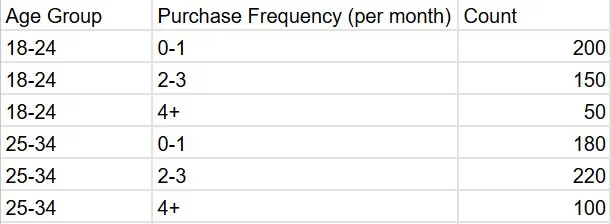Have you ever stared at a bar chart or pie chart, feeling like there must be more to the story? That's where crosstabs come in. While these basic visualizations offer a snapshot of your data, they often fall short in revealing the intricate relationships hidden within. Imagine trying to understand the complex interplay between customer age, purchase behavior, and product preference using only a simple bar chart. It's like trying to assemble a puzzle with only a few pieces.
Crosstabs are the missing piece. They provide a structured framework to organize and analyze your data, revealing patterns, trends, and unexpected connections. By going beyond mere observation and incorporating advanced statistical calculations, crosstabs become powerful tools for unlocking the full potential of your data. Let's embark on a journey to discover how crosstabs can transform your data analysis and lead to groundbreaking insights.

Demystifying Crosstabs - A Hands-on Example
Let's dive into a real-world example to understand how crosstabs work. Imagine an online retailer wanting to analyze the relationship between customer age and purchase frequency.
Understanding the Crosstab
A crosstab for this example would display customer age groups in rows and purchase frequency categories in columns. The cells within the table would show the count of customers falling into each combination of age and purchase frequency.
Example Crosstab:

Interpreting the Crosstab
- Reading Row and Column Values:
- Each row represents a specific age group.
- Each column represents a purchase frequency range.
- The numbers within the cells indicate the count of customers falling into that particular combination. For instance, 200 customers aged 18-24 made 0-1 purchases per month.
- Identifying Patterns:
- By analyzing the numbers in the crosstab, you can identify patterns. For example, you might notice that the 25-34 age group has a higher count in the "2-3 purchases per month" category compared to the 18-24 age group. This suggests that this age group tends to shop more frequently.
- You could also calculate percentages to understand the proportion of customers within each age group falling into different purchase frequency categories.
By examining the crosstab, the online retailer can gain valuable insights into customer behavior and tailor their marketing strategies accordingly. They might focus on increasing purchase frequency among the 18-24 age group or develop targeted campaigns for the 25-34 age group based on their higher purchase frequency.
In the next section, we'll explore how advanced crosstabs can take this analysis even further.
The Power of Advanced Crosstabs: Going Beyond the Basics
While basic crosstabs provide a foundation for data exploration, advanced crosstab features unlock deeper insights and more robust analysis. Let's explore some of these powerful capabilities:
Built-in Statistical Calculations
Imagine being able to assess the statistical significance of the patterns you observe in your crosstab. Advanced crosstab tools often incorporate built-in statistical tests like the chi-square test. This test helps determine if there's a statistically significant relationship between the variables. For instance, you could use a chi-square test to determine if the observed differences in purchase frequency across age groups are likely due to chance or if there's a genuine association.
Additionally, correlation coefficients can measure the strength and direction of the relationship between two variables. While not directly applicable to categorical data like our age group and purchase frequency, correlation coefficients can be useful when analyzing numerical variables within a crosstab.
Variable Grouping
To gain a more nuanced understanding of your data, advanced crosstabs allow you to group variables. In our example, instead of analyzing purchase frequency for broad age groups, you could create narrower age ranges (e.g., 18-22, 22-26, 26-30) to identify finer-grained patterns. Similarly, you could group purchase frequency into categories like "low," "medium," and "high" to simplify analysis.
Variable grouping empowers you to explore data at different levels of granularity, uncovering hidden patterns or subgroups within your dataset.
Top-Box Analysis
Often, researchers are interested in the most frequent or desirable responses within a category. Top-box analysis focuses on these top-performing segments. For example, you might want to identify the age group with the highest proportion of customers making frequent purchases (4+ per month).
By prioritizing these top-box segments, you can gain valuable insights into customer preferences, market trends, and opportunities for optimization.
Incorporating these advanced features into your crosstab analysis can significantly enhance your ability to uncover meaningful insights, make data-driven decisions, and communicate your findings effectively.

Benefits of Using Advanced Crosstabs
Streamlined Data Analysis
Advanced crosstab tools are designed to simplify the data analysis process. By integrating various calculations and functionalities within a single platform, they save researchers significant time and effort. Instead of manually performing statistical tests, calculating percentages, or creating visualizations, analysts can focus on interpreting results and deriving meaningful insights. This efficiency boost allows for quicker turnaround times and more agile decision-making.
Enhanced Accuracy and Depth
Built-in statistical calculations and advanced features ensure the accuracy and reliability of your findings. By automating complex computations, the risk of human error is reduced, leading to more trustworthy results. Moreover, beyond surface-level patterns, advanced crosstabs enable you to delve deeper into the data, uncovering hidden relationships and nuances. This comprehensive understanding empowers you to make more informed and precise conclusions.
Improved Decision-Making
The insights derived from advanced crosstab analysis can be instrumental in driving effective decision-making. By identifying key trends, patterns, and relationships within your data, you can make data-driven choices that are more likely to yield positive outcomes. For instance, understanding which customer segments have the highest purchase frequency can inform targeted marketing campaigns or product development efforts. Additionally, by assessing the statistical significance of your findings, you can prioritize actions with a higher probability of success.
Automating Crosstab Creation: The BioBrain Advantage
The era of manual data manipulation and time-consuming crosstab creation is behind us. ResTech platforms like BioBrain harness the power of automation to streamline the entire process, making it accessible to users of all technical backgrounds.
Automated Data Processing and Tabulation
At the heart of efficient crosstab creation is the ability to process and tabulate data swiftly and accurately. BioBrain excels in this area by offering:
- Instantaneous Data View: Users can visualize their entire dataset, both weighted and unweighted, in a tabulated format with just a few clicks.
- Dynamic Tabulation: The ability to apply banners on the fly allows for rapid customization of the data view, enabling users to focus on specific segments or variables of interest.
Crosstabs at Your Fingertips
BioBrain takes crosstab creation to the next level by integrating advanced statistical calculations directly into the crosstab itself. This means that users can:
- Access Statistical Insights Instantly: Key statistical measures like percentages, chi-square values, and correlation coefficients are readily available within the crosstab, eliminating the need for separate calculations.
- Make Data-Driven Decisions Faster: With critical statistical information at their fingertips, users can quickly identify trends, patterns, and relationships within the data, accelerating the decision-making process.
By automating data processing, tabulation, and statistical calculations, BioBrain empowers users to spend less time on technical tasks and more time uncovering valuable insights from their data.
Crosstabs are invaluable tools for extracting meaningful insights from your data. By organizing information in a clear and structured manner, they provide a solid foundation for analysis. When equipped with advanced features like built-in statistical calculations, variable grouping, and top-box analysis, crosstabs become even more powerful.
Solutions like BioBrain further revolutionize the process by automating data processing, tabulation, and statistical calculations. This streamlined approach empowers users to focus on interpretation and decision-making rather than technical complexities.
By harnessing the potential of crosstabs and leveraging advanced tools, you can unlock hidden patterns, make informed decisions, and gain a competitive edge.
Processing fraudulent data for statistical calculations can reap negative results. Unlock the power of automated QC by reading the blog here.











